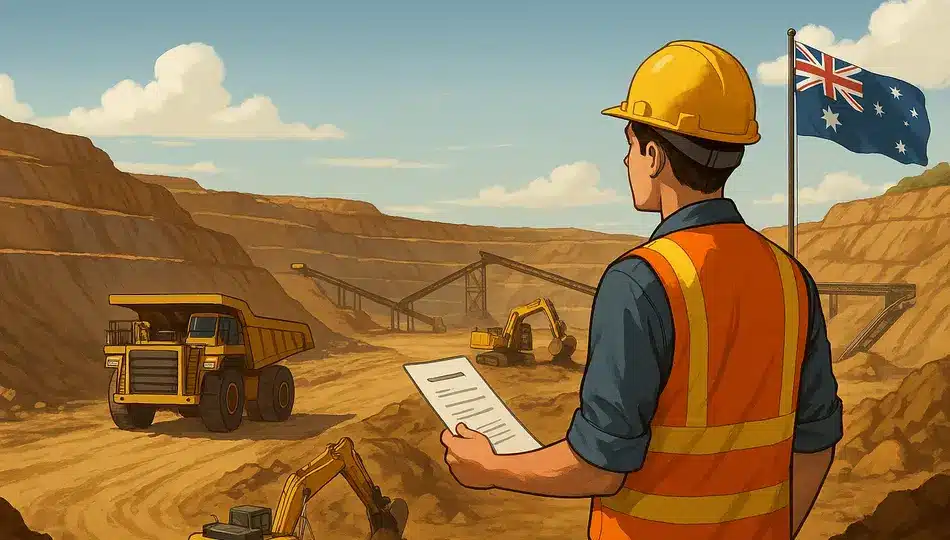In recent years, Australia’s mining industry has become a magnet for workers chasing high wages, unique lifestyle opportunities, and the promise of steady employment. From fly-in fly-out (FIFO) schedules to camp living, the sector offers something very different from traditional 9-to-5 jobs. But while glossy videos on social media often show stacks of cash and Bali holidays, they rarely explain how ordinary people with no family connections or trade background can actually land their first mining job.
This feature takes an honest, ground-level look at how newcomers break into mining. It’s based on the real experience of one worker who moved from New Zealand to Western Australia with no prior mining history and managed to land a camp job within months. The journey shows what it really takes the paperwork, the persistence, and the mindset needed to survive the demanding FIFO lifestyle.
Why Mining Jobs Are in Demand
Australia is one of the world’s largest producers of iron ore, coal, gold, and critical minerals like lithium. Mining accounts for nearly 14% of national GDP and directly employs more than 280,000 people, according to government data.
High demand for resources means strong demand for workers. Yet the industry struggles with labor shortages. A 2023 Minerals Council report warned that mining would need an additional 24,000 workers by 2027, with many roles available at entry level.
For workers, that means opportunity. While skilled positions like drillers, operators, and tradespeople can pay more than $150,000 a year, even entry-level roles such as camp utilities can pay $70,000–$90,000 annually. That’s why thousands of Kiwis, Brits, Irish, and Filipinos make their way to Australia every year in search of mining jobs.
Fill Critical Roles in Mining
Post your job on WhatJobs and reach skilled tradespeople, engineers, and entry-level workers ready to power the future of the mining industry.
Post a Job Now →Step 1: Get the Right to Work
The first hurdle is legal. No company will hire you without the proper visa.
- New Zealand citizens: You receive a special visa automatically upon arrival in Australia, allowing you to live and work indefinitely. This makes Kiwis some of the most common faces on mine sites.
- Working holiday visas: Popular among younger workers from the UK, Ireland, and other countries. These usually last one to two years, but can sometimes lead to company sponsorship.
- Skilled visas and sponsorships: Harder to get at the start, but once you’ve proven yourself, some companies may offer sponsorship to keep you long-term.
Without a visa, there is no pathway. Recruiters are strict about this.
Step 2: Set Up the Essentials
Once you have a visa, employers expect you to have basic financial and identification details ready:
- Tax File Number (TFN) — required for payroll.
- Australian bank account — wages are paid directly.
- Superannuation account — the retirement savings fund every worker must have.
- Local address and phone number — shows you’re serious and available.
For FIFO work, having an address in Perth (the main hub for Western Australia’s mines) gives a strong advantage. Recruiters prefer applicants who can be called in for interviews at short notice.
A full driver’s licence is also essential for most site jobs. A four-wheel drive certification is not mandatory, but it helps.
Step 3: Apply Relentlessly
Breaking into mining takes persistence. Job seekers should:
- Use SEEK, Indeed, whatjobs and company websites to apply for dozens of roles.
- Target entry-level ads, even if they list “6 months experience required.” Many companies hire newcomers who show enthusiasm.
- Tailor your resume for each job. Highlight transferable skills:
- Hospitality experience for camp jobs (bar work, kitchens, cleaning).
- Construction or labouring for on-site assistant roles.
AI tools like ChatGPT can polish a resume in minutes, but honesty matters. Don’t claim experience you don’t have — recruiters know turnover is high and prefer genuine, reliable applicants.
Step 4: Know the Entry Points
Most people with no experience start as utilities, also known as “service crew” or “camp staff.”
These jobs cover:
- Housekeeping and cleaning
- Laundry
- Kitchen hand work
- Gardening and grounds maintenance
- Bar shifts in camp mess halls
It’s not glamorous, but it pays well compared to city hospitality jobs and gets your foot in the mining system.
Utilities often act as a springboard to better roles. Bar shifts, for example, put you in direct contact with miners and supervisors every evening. Many workers start here and, through networking, move on to become dump truck operators or trades assistants.
Step 5: Interview Preparation
Once you land an interview, preparation is crucial:
- Arrive early — if the interview is at 9 a.m., be there by 8:45.
- Dress neatly, even if it’s a casual role.
- Bring a printed copy of your resume.
- Be upfront about your lack of mining experience. Emphasize willingness to learn, reliability, and transferable skills.
Companies know utilities turnover quickly. If you present yourself as committed, positive, and prepared for hard work, you’ll stand out.
Step 6: Expect the FIFO Lifestyle
Life in mining is demanding. Shifts are long — often 12 hours a day for 14 to 28 days straight. Conditions are hot, dusty, and physically draining.
Isolation is also a challenge. Camps are often far from towns, and workers can feel lonely or “trapped” in routine. Mental health is a serious issue in mining, with many workers reporting stress or burnout.
To survive, it helps to:
- Set a clear financial or personal goal before going up.
- Stay social and positive — avoid “negative nancies” who complain constantly.
- Keep in touch with family during rest breaks.
Step 7: Upskill and Move Up
Landing your first role is just the start. If you want to advance:
- Use R&R (rest and recovery) time to gain certifications. Valuable tickets include:
- Working at Heights
- Confined Spaces
- Basic Rigging and Dogging
- Scaffolding
- These courses cost $1,000–$2,000 each, but paying for them yourself shows commitment.
This investment helps you transition from camp work into higher-paid site jobs like driller’s offsider, trades assistant, or operator.
Step 8: Consider Shutdown Work
Another entry pathway is shutdown contracts.
Mines periodically close for maintenance and bring in hundreds of temporary workers. Shutdown jobs are intense, but they:
- Provide short bursts of high income.
- Build experience quickly.
- Introduce you to supervisors who may offer longer FIFO contracts.
Agencies like Hayes and Programmed often manage shutdown recruitment.
Step 9: Build a Reputation
Mining is a small world. Recruiters and HR managers talk. To build credibility:
- Always be available for shifts.
- Don’t cancel at the last minute.
- Be reliable, on time, and safe.
- Treat HR staff with respect — they control opportunities.
Once you’ve proven yourself, job offers come more frequently.
Step 10: Plan for the Future
After a year or two, you’ll face a choice:
- Stay in utility roles for steady but modest income.
- Upskill into trades or machinery roles for six-figure pay.
- Transition into oil and gas, where offshore work can be even more lucrative.
Either way, the first mining job is the hardest to land. From there, opportunities multiply.
Companies and Recruiters to Know
If you’re just starting out, these names are worth remembering:
- ESS (Compass Group): One of the largest employers of camp staff in Australia.
- Sodexo: Another big player in hospitality and utilities.
- Hayes Recruitment: Strong in temporary and shutdown staffing.
- Programmed & Programmed Marine: Contracts across mining and offshore.
These companies are often the first step for workers with no experience.
The Reality vs. the Hype
Social media influencers love to glamorize mining life with images of fast cars and tropical getaways. The truth is more balanced. Mining jobs offer:
- High pay compared to other entry-level work.
- Opportunities to upskill and grow.
- A lifestyle that can be rewarding if you’re disciplined.
But they also demand:
- Long hours in harsh conditions.
- Time away from family.
- A strong mental attitude to cope with isolation.
If you’re prepared for the grind, mining can be life-changing.
FAQs
1. Can I get a mining job in Australia with no experience?
Yes. Most people start in entry-level utility roles such as housekeeping, bar work, or kitchen hand positions. From there, you can network and move into higher-paid site jobs.
2. Do I need special tickets or certifications before I start?
Not for camp jobs. But if you want to move into machinery or trade roles, tickets like Working at Heights, Confined Spaces, and Rigging are valuable.
3. How long does it usually take to get hired?
It varies. Some applicants land a job within weeks; others take 2–3 months. Having a local address in Perth or another mining hub makes the process faster.
4. How much can I realistically earn?
Entry-level camp utilities can make $70,000–$90,000 a year. Skilled roles such as drillers, operators, and tradespeople can exceed $150,000.
Conclusion
Australia’s mining industry isn’t an easy ride. It requires grit, flexibility, and patience. But for ordinary people — including newcomers from overseas — it offers a rare chance to transform their income and career trajectory in just a few years.
The first step is simply to get a foot in the door. Take any role, prove your reliability, and use it as a platform to build the future you want.




